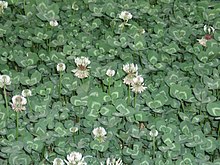Lotaustralin
Lotaustralin ist ein cyanogenes Glycosid, welches in geringer Menge in der namensgebenden Leguminose Lotus australis,[1] in Maniok (Manihot esculenta), in der Limabohne (Phaseolus lunatus)[3], der Rosenwurz (Rhodiola rosea)[4], Weiß-Klee (Trifolium repens)[5] und anderen Pflanzen gefunden wurde.
| Strukturformel | ||||||||||
|---|---|---|---|---|---|---|---|---|---|---|

| ||||||||||
| Allgemeines | ||||||||||
| Name | Lotaustralin | |||||||||
| Andere Namen |
(2R)-2-Methyl-2-{[(2S,3R,4S,5S,6R)-3,4,5-trihydroxy-6-(hydroxymethyl)tetrahydro-2H-pyran-2-yl]oxy}butanenitril | |||||||||
| Summenformel | C11H19NO6 | |||||||||
| Kurzbeschreibung |
farblose Nadeln[1] | |||||||||
| Externe Identifikatoren/Datenbanken | ||||||||||
| ||||||||||
| Eigenschaften | ||||||||||
| Molare Masse | 261,27 g·mol−1 | |||||||||
| Aggregatzustand |
fest[2] | |||||||||
| Schmelzpunkt | ||||||||||
| Löslichkeit |
gut löslich in Essigsäureethylester[1] | |||||||||
| Sicherheitshinweise | ||||||||||
| ||||||||||
| Wenn nicht anders vermerkt, gelten die angegebenen Daten bei Standardbedingungen (0 °C, 1000 hPa). | ||||||||||

(Trifolium repens)

Das Epimer (S)-Epilotaustralin kommt vorwiegend in Passionsblumen und dem Zweikorn Triticum dicoccum vor.[6]
Lotaustralin besitzt als Aglycon das Butanoncyanhydrin, als Zuckereinheit die β-D-Glucose und ist somit strukturell verwandt mit Linamarin, das Acetoncyanhydrin als Aglycon trägt. Die beiden Glycoside unterscheiden sich lediglich durch das jeweilige Aglycon, das sich vom Aceton (Linamarin) bzw. dem Butanon (Lotaustralin) ableitet. In vielen Pflanzen werden auch beide Homologe sowie das Epimere Epilotaustralin gefunden, da die Enzyme der Biosynthese der drei Stoffe dieselben sind. Diese können sowohl Isoleucin zu Lotaustralin oder Epilotaustralin, als auch Valin zu Linamarin umsetzen.[7]
Das Enzym Linamarase kann beide Glycoside spalten, wobei die sehr giftige Blausäure entsteht; deshalb zählt Lotaustralin zu den Cyanogenen Glycosiden. Die Toxizität von Linamarin, Lotaustralin und Epilotaustralin liegen auf ähnlichem Niveau.[6]
Einzelnachweise
Bearbeiten- ↑ a b c d Shmuel Yannai: Dictionary of Food Compounds with CD-ROM: Additives, Flavors, and Ingredients. CRC Press, 2003, ISBN 978-1-58488-416-3, S. 688.
- ↑ a b c Datenblatt Lotaustralin 95% (LC/MS-ELSD) bei Sigma-Aldrich, abgerufen am 1. Januar 2024 (PDF).
- ↑ Frehner M, Scalet M, Conn EE: Pattern of the Cyanide-Potential in Developing Fruits : Implications for Plants Accumulating Cyanogenic Monoglucosides (Phaseolus lunatus) or Cyanogenic Diglucosides in Their Seeds (Linum usitatissimum, Prunus amygdalus). In: Plant Physiol. 94. Jahrgang, Nr. 1, 1990, S. 28–34, PMID 16667698 (englisch).
- ↑ Akgul Y, Ferreira D, Abourashed E, Khan I: Lotaustralin from Rhodiola rosea roots. In: Fitoterapia. 75. Jahrgang, Nr. 6, 2004, S. 612–4, doi:10.1016/j.fitote.2004.06.002, PMID 15351122 (englisch).
- ↑ Notes on poisoning: Trifolium repens. Canadian Poisonous Plants Information System, 30. Mai 2006, archiviert vom am 7. Februar 2012; abgerufen am 11. Februar 2007 (englisch).
- ↑ a b J. B. Harborne, H. Baxter, G. P. Moss: Phytochemical dictionary: a handbook of bioactive compounds from plants. 2. Auflage, CRC Press, 1999, ISBN 978-0-7484-0620-3, S. 103.
- ↑ J. P. F. D’Mello, C. M. Duffus, J. H. Duffus: Toxic substances in crop plants. Woodhead Publishing, 1991, ISBN 978-0-85186-863-9, S. 208.